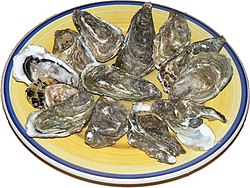

Shellfish, in colloquial and fisheries usage, are exoskeleton-bearing aquatic invertebrates used as food, including various species of molluscs, crustaceans, and echinoderms. Although most kinds of shellfish are harvested from saltwater environments, some are found in freshwater. In addition, a few species of land crabs are eaten, for example Cardisoma guanhumi in the Caribbean. Shellfish are among the most common food allergens. [1]
Contents
- Terminology
- Shellfish in various cuisines
- In Japan
- In the United States
- Religious dietary restrictions
- Allergy
- Toxic content
- Ecosystem services and reef-building
- See also
- References
- Sources
- External links
Due to narrowing in the meaning of the English word fish over the centuries, shellfish no longer fall under what is usually considered fish. [2] Most shellfish are low on the food chain and eat a diet composed primarily of phytoplankton and zooplankton. [3] Many varieties of shellfish, and crustaceans in particular, are actually closely related to insects and arachnids; crustaceans make up one of the main subphyla of the phylum Arthropoda. Molluscs include cephalopods (squids, octopuses, cuttlefish) and bivalves (clams, oysters), as well as gastropods (aquatic species such as whelks and winkles; land species such as snails and slugs).
Molluscs used as a food source by humans include many species of clams, mussels, oysters, winkles, and scallops. Some crustaceans that are commonly eaten are shrimp, lobsters, crayfish, crabs and barnacles. [4] Echinoderms are not as frequently harvested for food as molluscs and crustaceans; however, sea urchin gonads are quite popular in many parts of the world, where the live delicacy is harder to transport. [5] [6]
Though some shellfish harvesting has been unsustainable, and shrimp farming has been destructive in some parts of the world, shellfish farming can be important to environmental restoration, by developing reefs, filtering water and eating biomass.







